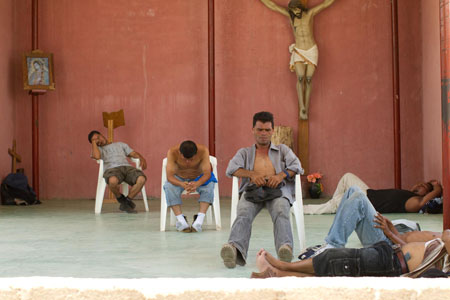This unusual documentary begins, as so many border stories do nowadays, with a lonely death. Someone was trying to cross the punishing Arizona desert to secure their place in the United States, having come over from Mexico as the final leg of a journey that may have begun even further south, in Guatemala, Honduras, El Salvador or beyond. The body of a man, beginning to decompose in the desert sun, is found in August of 2010. He bears no ID, and only a prayer pamphlet in his pocket. Sometimes people die together, like when a group of migrants is overtaken by the narco-wars, double-crossed by their coyote, or left to bake in an overcrowded cargo hold. But usually, those who try and fail to cross over into the U.S. from the south are those who fall behind, who become separated from a group and run out of water, lose their way, or just cannot manage to survive the brutal elements. This man was one of them, and various authorities struggle to identify him so his remains might be returned to his family.
[Editor’s note: See also Kevin B. Lee’s video essay: “Three Movies in One: Who Is Dayani Cristal?“]
This case is a little different, however, since the deceased migrant bears one striking distinguishing mark: a tattoo across his chest that reads “Dayani Cristal.” Is this the man’s name? The name of a loved one? Is it a name at all? Given this rather prominent clue, identifying this body should be somewhat easier than the other case files, numbering thousands in Arizona alone. We learn about the difficult, seldom successful process of identifying deceased migrants, despite the collective efforts of the Tucson city medical examiner, an investigative assistant from an immigrant rights NGO, and a team of dedicated workers at the Mexican consulate. Since all of the identifying information that places most citizens on the grid for missing persons databases involve either legal categories (drivers’ licenses, social security numbers) or run-ins with police (fingerprints, mugshots), there is next to nothing for forensic investigators to go on when trying to figure out who these men and women were. The researchers work in tandem to form a database regarding migrant deaths, but it mostly consists of pieces from a series of tragically incomplete puzzles: scraps of clothing, emptied wallets, photo lockets, bank notes, coded addresses and, of course, dental records, partial fingerprints and DNA results for people who were most likely not in the systems of any nation, and whose families are very likely too scared of the Federal government (ours and theirs) to go looking.
Director Marc Silver and executive producer Gael Garcia Bernal have taken the fundamental mystery of “Dayani Cristal” and paired with a single story of a Honduran migrant, “Yohan,” who left his wife and children to pursue better paying work in the States. In addition to a series of interviews with those who knew and loved Yohan, the film follows Garcia Bernal as he retraces the probable route that Yohan traveled, from his home and across multiple borders, to his final attempted move into the U.S. which resulted in his death. Although Garcia Bernal’s curious and chipper demeanor can be a bit incongruous, given the subject and the circumstances of the other people he meets along the way, he takes the viewer on a journey whose common travelers depend on their invisibility. One of the things we witness along with Garcia Bernal, which should not surprise us but that we simply don’t have the opportunity to observe very often, is the vibrancy of the cultures and communities that the migrants are leaving behind. This lends an additional poignancy to their sacrifice.
Who Is Dayani Cristal? is indeed a mystery procedural, while at the same time a deeply humanistic engagement with illegal immigration, an issue that has been so thoroughly politicized that the very basic desires of those most affected by it have tended to be occluded by rhetoric and bad law. (Near the start of the film, we hear a news report regarding a federal judge striking down key provisions in SB1070, Arizona’s draconian border patrol law.) When Silver and Garcia Bernal take us into a forensics bureau and, as casually as a lost and found box, we see a box on a shelf labeled “skulls in bins,” we are forced to think about our own part in this ongoing behemoth of death and denial. Ours is a global system of capital and labor, and one nation’s fortunes are tied to the material situations of others: cheap labor, lax regulations, a lower standard of living, you name it. But as we know, money and bodies do not have equal rights of circulation, and some humans are forever lost to the debit column. So as horrifying as these lost souls and their misfiled body parts truly are, Who Is Dayani Cristal? shows us something no less disturbing for being so matter of fact. The skull file is part of a grand ledger sheet, the mounting human toll of a ghoulish economics of dependency. Trying to learn the identities of the dead and repatriate their remains is but a noble attempt to make a down payment on an irreconcilable debt.





